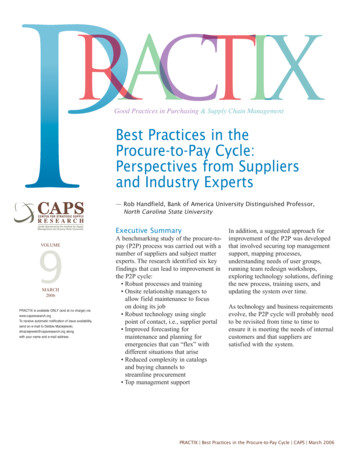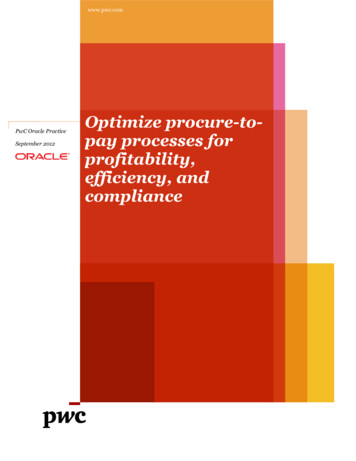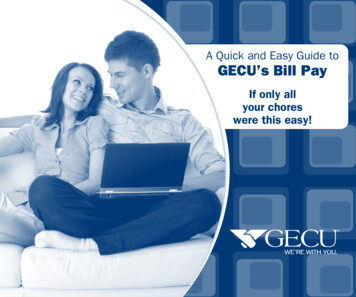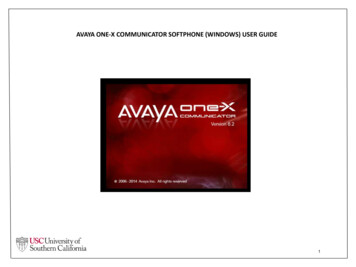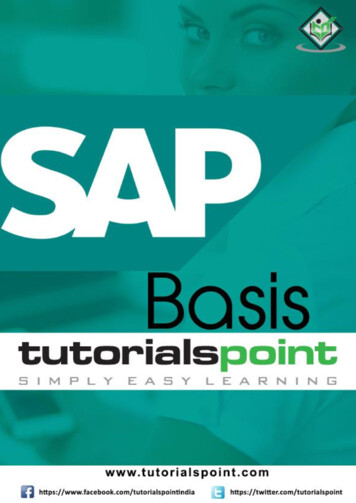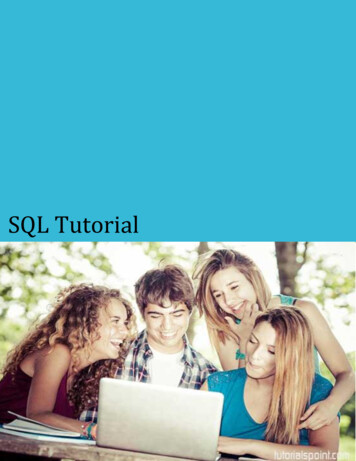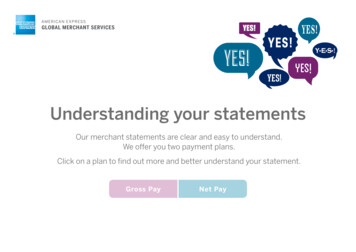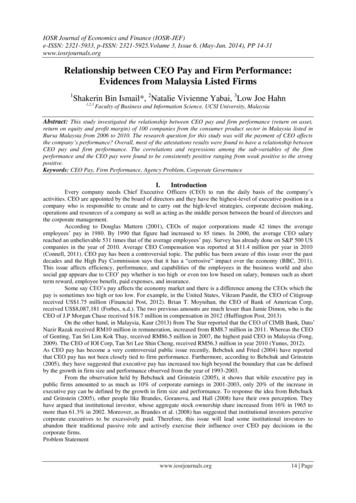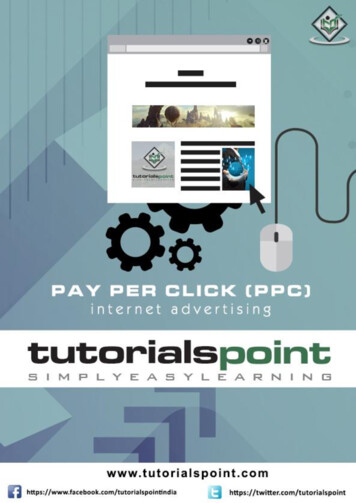
Transcription
Pay Per Click1
Pay Per ClickAbout the TutorialPay Per Click (PPC) is an internet advertising system meant to direct online traffic to particularwebsites where the advertiser pays the publisher a certain price when an ad is clicked. Thisis a brief tutorial that explains how you can use PPC to your advantage and promote yourbusiness.AudienceThis tutorial is primarily going to help all those readers who are into advertising andspecifically those who aspire to make a career in Internet Marketing.PrerequisitesBefore proceeding with this tutorial, you should have a good understanding of thefundamental concepts of marketing, advertising, and analyzing product and audience.Disclaimer & Copyright Copyright 2018 by Tutorials Point (I) Pvt. Ltd.All the content and graphics published in this e-book are the property of Tutorials Point (I)Pvt. Ltd. The user of this e-book is prohibited to reuse, retain, copy, distribute, or republishany contents or a part of contents of this e-book in any manner without written consent ofthe publisher. We strive to update the contents of our website and tutorials as timely and asprecisely as possible, however, the contents may contain inaccuracies or errors. TutorialsPoint (I) Pvt. Ltd. provides no guarantee regarding the accuracy, timeliness, or completenessof our website or its contents including this tutorial. If you discover any errors on our websiteor in this tutorial, please notify us at contact@tutorialspoint.com.i
Pay Per ClickTable of ContentsAbout the Tutorial . iAudience . iPrerequisites . iDisclaimer & Copyright. iTable of Contents . ii1.PPC — INTRODUCTION . 1About PPC Ad . 1Search Engine Advertising . 2Entities Involved in PPC Advertising . 3Workflow of a PPC Ad . 5History of PPC . 5Properties of a Compelling PPC Ad . 6General Formula for Calculating PPC . 6Advantages of PPC . 62.PPC — TERMINOLOGY . 7Ad group . 7Ad Network . 7Ad Position . 7Ad Rank . 7Call-To-Action (CTA) . 7Campaign . 7Click-Through-Rate (CTR). 7Conversion . 7Conversion Rate . 8Cost Per Action . 8Cost Per Click (CPC) . 8ii
Pay Per ClickCost Per Mille (CPM) . 8Destination URL . 8Display URL . 8Geo-targeting . 8Impression . 8Keyword . 8Landing Page . 9Negative Keywords . 9PPC Bid . 9Prospect . 9Quality Score . 9Search Engine Result Page (SERP) . 9Split Testing . 93.PPC — CREATING A KEYWORD LIST. 10Categorizing the Keywords . 10Building a Keyword List . 11How Long Can the Keyword List Be?. 13Keyword Research Tools . 13Keyword Match Types . 13Negative Keywords . 144.PPC — SETTING TARGET LOCATION & LANGUAGE . 16Geographic Location of Users . 16Demographics of Users . 17Language . 175.PPC — WRITING A KILLER PPC AD . 19Creating a PPC Ad . 19Market and Audience Research . 19iii
Pay Per ClickKeyword Research. 20Build Pay-Per-Click Ad . 20Build Landing Pages. 20Track, Measure, and Report . 20Optimize the Ad . 20Elements of a PPC Ad . 20Creating a PPC Ad Using Google AdWords. 216.PPC — LANDING PAGES . 24Types of Landing Pages . 24Elements of an Effective Landing Page . 24Creating a Well-Formatted and Informative Landing Page . 25Testing the Landing Page . 267.PPC — BIDDING . 27PPC Bidding . 27Factors that Affect Bidding . 27What to Bid For? . 27Pricing Strategies. 27How Much To Bid? . 28PPC Bid Management Solutions . 28Factors to Confirm Before Bidding. 298.PPC — MEASURING RESULTS . 309.PPC — PPC AD ON GOOGLE . 31Creating Google AdWords Account . 31Creating a PPC Campaign in Google AdWords . 3610. PPC — YAHOO! AND BING SEARCH MARKETING . 46Structure of an Ad Account . 46iv
Pay Per ClickCreating a PPC Ad on AdCenter . 46Bidding . 47Key Features . 47Yahoo/Bing Ads Editor . 48Budget and Billing . 49Campaign Optimization . 49Conversion Tracking . 5011. PPC — FACEBOOK ADS . 51Overview . 51Setting up an Advertising Account . 51Following Up Your Account . 58Managing the Ad . 59v
Pay Per Click1. PPC — INTRODUCTIONWe have the Internet that provides a huge platform for advertising products and servicesonline. Advertisers around the world have shown a keen interest in making good use of theInternet that is omnipresent these days to market various products and speed up theirbusiness activities by reaching out to numerous users.You might be aware of the conventional methods of push marketing that involves the useof brochures, television ads, radio ads, banners, bills, balloons, etc. where people are drivento hear, listen, and view the product or service they can get.Quite contrary to the traditional model, the recent methods of internet marketing involveinnovative techniques to catch more eyeballs and pull online traffic to visit, listen, view, orbuy a product or a service that is on offer. It is done through a model that is now being widelyregarded as Pay Per Click (PPC). It is a successful model for internet advertising that directsonline traffic to particular websites, where the advertisers pay the publishers a certain amountwhen their ad is clicked.Here, in this introductory chapter, we will provide an overview of PPC as a concept and explainthe role of its entities involved in the entire workflow of PPC advertising.About PPC AdPPC stands for Pay Per Click. It is an internet marketing model where the advertisers use thepublishers’ website to market their products or services through ads. The publisher gets paidby the particular advertisers when a user clicks on their ads. It is a pull-type internetmarketing of buying user visits to a site.1
Pay Per ClickSearch Engine AdvertisingOne of the most popular forms of PPC marketing is Search Engine Advertising (SEA). It allowsadvertisers to bid for placement of ads in the search engine’s sponsored link, when a usersearches for a keyword that is relevant to a product or a service.Whenever a user clicks on an ad, the link directs the user to the product’s website. At thesame time, the product or service provider needs to pay some amount to the search engine,such as Google.Behind every successful PPC campaign lies a catchy ad that can attract the attention of onlineusers. Advertisers focus on the following aspects while creating an online ad: Research for effective keywords related to a product or a service Choose the right keywords Group the keywords relevantly Arrange the keywords to create an advertiseMore often than not, the ads that are useful and relevant are charged less fees per click bythe search engines. This is rewarding for the advertisers, as they get more business inexchange of minimal fees.Google AdWords is an example of a popular advertising system. It facilitates businesses topublish ads on Google’s search engine.2
Pay Per ClickEntities Involved in PPC AdvertisingThe following entities are involved in PPC Advertising: Product or Service Seller PPC Advertiser Landing Page Provider Landing Page Viewer or the VisitorTake a close look at the illustrations below that depict the general roles of the entities involvedin PPC advertising:(a) A product/service seller contacts advertisers for PPC based Ad programs3
Pay Per Click(b) PPC Advertiser creates Ads and provides landing pages for Ads(c) Users click the Ads and visit the landing pages4
Pay Per Click(d) PPC – Bird’s eye viewWorkflow of a PPC AdThe workflow of a PPC ad is as follows:1. First of all, the advertiser creates an online account and loads her account with somemoney – say Rs 5000. Note that some organizations allocate their PPC budgets inhundreds, thousands, or even millions of rupees per month.2. The advertiser creates a small text ad. In some cases, a PPC ad can include images.3. The advertiser specifies a list of keywords associated with the ad.4. The advertiser determines how much she is ready to pay each time someone clicks onthe ad.5. On the buyer’s side, a user visits the search engine – say Google.com, enters one of thekeywords or keyword phrases - say “Kindle Paper white” and clicks the Search button.6. The search engine finds the matching ads and places them on the results page.7. If a user clicks on the ad, she is taken to the advertiser's website, and the advertiser ischarged for the click.History of PPCPPC ads have been in existence over a decade now. The term PPC came into existence duringthe year 1990 when organizations started conducting their business on the Internet. One ofthe companies that pioneered the concept was goto.com. Yahoo took it over in 2003.When Google launched its AdWords solution for PPC marketing, heavy activities started in thedomain of PPC. In addition to Google, a number of search engines such as Yahoo, Bing,7Search, ABCSearch, and Findology provide PPC ad hosting.5
Pay Per ClickProperties of a Compelling PPC AdA compelling PPC ad has the following properties: It is a part of a closely-knit ad-groups. It can address the desired search queried by the users. It takes the user to an appropriate landing page. It drives the users to click on it and explore.General Formula for Calculating PPCThe basic formula of calculating PPC is:Pay per click ( ) Advertising cost ( ) Number of ad clicksAdvantages of PPCPPC helps in branding and creating leads as well, both in parallel. PPC provides quick resultsin contrast to SEO results that are equally important but may take months or even years tomaterialize. Quick ActionsPPC gives immense traffic, quick results, and more hypebranding in a short span of time. Negligible Initial Investment Business Gets Noticed GloballySearch engines do not charge fees to insert a PPCad or to set up an account. The user pays only when someone actually clicks on hisad.A business can get global recognition,even if it has a small local setup. As compared to SEO methods, PPC ads can deliver fasterresponse, if quality ads are posted.Instant Results6
Pay Per Click2. PPC — TERMINOLOGYGiven below is a list of the terms frequently used in PPC advertising followed by a shortdescription of the terms. You should be thorough with these terms before proceeding further.Ad groupIt is a collection of relevant keywords under one name. Maximum 20,000 keywords can beadded into an Ad Group.Ad NetworkAn Ad Network is an online business that specializes in matching up of advertisers to thewebsites looking to host the ad. Ad networks work as brokers for both suppliers (sites withcontent that can host ads, for example, tutorialspoint.com) and buyers (the advertisers). Anad network relieves the websites from having to set up and invest in their own ad servers andtracking software.Ad PositionAd position is the order in which an ad is displayed on a webpage. For example, ad position"1" means the ad is displayed first on the webpage.Ad RankIt is a value used to determine the Ad Proposition.Call-To-Action (CTA)This is a marketing term used for the action you want the website visitor to take.CampaignIt is a series of relevant ad groups.Click-Through-Rate (CTR)It is a metric showing how often a visitor clicks your ad after seeing it. It can be defined asthe number of clicks per thousand impressions. CTR contributes to Ad Rank.ConversionConversion is the action the user wants when he clicks on an ad. It occurs when a visitortakes action. For example, the user makes purchases, signs ups, submits enquiry forms, viewsa page, or downloads, depending on the program's goals.7
Pay Per ClickConversion RateIt is the measurement of the success of a paid campaign. It is measured by the number ofpotential visitors performing any of the desired actions such as buying a product, filling aform, etc.For example, if there are 100 visitors to a particular webpage via a PPC ad, and three of those100 visitors buy the product the website sells, then the conversion rate for that particular adis three percent. The larger the conversion rate, the more successful the website is.Cost Per ActionIt is the amount you pay for every lead, sign-up, or purchases. It is also known as cost peracquisition.Cost Per Click (CPC)It implies the amount you pay for every single click on your ads.Cost Per Mille (CPM)It is the amount paid for every thousand views of the PPC ad.Destination URLIt is where you want the user to land when he clicks on the ad.Display URLIt is the name of a page of the website.Geo-targetingDelivery of ads to a particular geographic location of the users. It allows the advertisers tochoose specific locations where they wish to show their ads.ImpressionIn the context of online advertising, it is a measure of the number of times an ad is seenirrespective of clicking on it. Each time the ad displays, it is counted as one impression.KeywordIt is a search query made by a user. A word or a phrase of words entered in the search boxby the user. The search engine matches your keywords and gives you relevant results on theSearch Engine Result Page (SERP).8
Pay Per ClickLanding PageIt is any standalone webpage distinct from the main website on which the visitor lands.Negative KeywordsThey are the ones for which you do not want your ad to appear.PPC BidIt is the maximum amount of fees an advertiser is ready to pay for a click.ProspectProspect is a potential user who can buy a product/service being advertised.Quality ScoreIt is a dynamic metrics assigned to each of your keywords and ads. It determines the qualityof your keyword, ad, and the landing page. High quality score boosts the ad rank.Search Engine Result Page (SERP)The page that lists the results returned by the search engine in response to a user query.Split TestingIt is a classic method of testing an ad to determine the effectiveness of a PPC ad. It comparestwo versions of an ad that are identical except for one specific difference of a word or animage.9
Pay Per ClickEnd of ebook previewIf you liked what you saw Buy it from our store @ https://store.tutorialspoint.com10
When Google launched its AdWords solution for PPC marketing, heavy activities started in the domain of PPC. In addition to Google, a number of search engines such as Yahoo, Bing,
